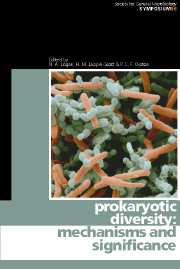Book contents
- Frontmatter
- Contents
- Contributors
- Editors' Preface
- Microbial diversity in the era of genomics
- Patterns in prokaryotic biodiversity
- A putative RNA-interference-based immune system in prokaryotes: the epitome of prokaryotic genomic diversity
- The significance of prokaryote diversity in the human gastrointestinal tract
- The genetics of phenotypic innovation
- Minimal genomes required for life
- Evolution of the core of genes
- Biogeographical diversity of archaeal viruses
- Is there a link between Chlamydia and heart disease?
- Unculturable oral bacteria
- Comparative genomics – what do such studies tell us about the emergence and spread of key pathogens?
- Spread of genomic islands between clinical and environmental strains
- Evolving gene clusters in soil bacteria
- Unusual micro-organisms from unusual habitats: hypersaline environments
- Genomic islands and evolution of catabolic pathways
- Horizontal gene transfer and its role in the emergence of new phenotypes
- Index
Spread of genomic islands between clinical and environmental strains
Published online by Cambridge University Press: 06 July 2010
- Frontmatter
- Contents
- Contributors
- Editors' Preface
- Microbial diversity in the era of genomics
- Patterns in prokaryotic biodiversity
- A putative RNA-interference-based immune system in prokaryotes: the epitome of prokaryotic genomic diversity
- The significance of prokaryote diversity in the human gastrointestinal tract
- The genetics of phenotypic innovation
- Minimal genomes required for life
- Evolution of the core of genes
- Biogeographical diversity of archaeal viruses
- Is there a link between Chlamydia and heart disease?
- Unculturable oral bacteria
- Comparative genomics – what do such studies tell us about the emergence and spread of key pathogens?
- Spread of genomic islands between clinical and environmental strains
- Evolving gene clusters in soil bacteria
- Unusual micro-organisms from unusual habitats: hypersaline environments
- Genomic islands and evolution of catabolic pathways
- Horizontal gene transfer and its role in the emergence of new phenotypes
- Index
Summary
COMMON FEATURES OF GENOMIC ISLANDS
The genome of a bacterium consists of a core that is common to all strains of a taxon and an accessory part that varies within and among clones of a taxon. The accessory genome represents the flexible gene pool that frequently undergoes acquisition and loss of genetic information and hence plays an important role for the adaptive evolution of bacteria (Dobrindt et al., 2004). The flexible gene pool is made up of accessory elements such as bacteriophages, plasmids, IS elements, transposons, conjugative transposons, integrons and genomic islands (GEIs).
GEIs are chromosomal regions that are typically flanked by direct repeats and inserted at the 3′ end of a tRNA gene. They contain transposase or integrase genes that are required for chromosomal integration and excision and further mobility-related genes. GEIs are clone- or strain-specific and are never found in all clones of a taxon. Most GEIs are easily differentiated from the core genome by their atypical G+C contents and atypical oligonucleotide composition, with steep gradients thereof at their boundaries (Reva & Tümmler, 2005). First identified in pathogenic bacteria (‘pathogenicity islands’), GEIs have since been detected in numerous non-pathogenic species. GEIs may confer fitness traits, increase metabolic versatility or adaptability or promote bacterium–host interaction in terms of symbiosis, commensalism or virulence (Dobrindt et al., 2004).
GEIs have been found in the majority of all currently completely sequenced bacterial genomes, but there is a bias towards Gram-negative bacteria and life in microbial communities.
- Type
- Chapter
- Information
- Prokaryotic DiversityMechanisms and Significance, pp. 187 - 200Publisher: Cambridge University PressPrint publication year: 2006
- 4
- Cited by

